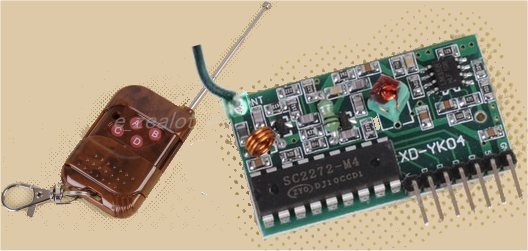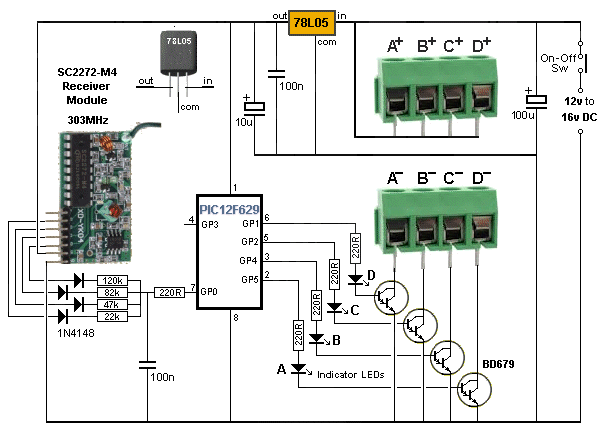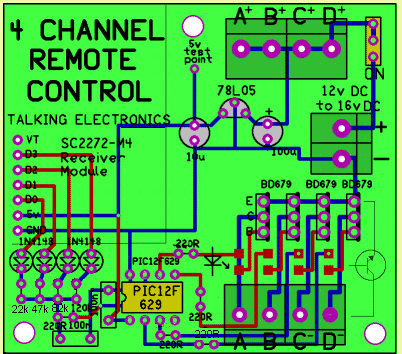|
4 CHANNEL REMOTE CONTROL |
|
|
Why re-invent the
wheel?
TRANSMITTER / RECEIVER
SPECIFICATIONS
Transmitter: The transmitter is a
fob-sized case with four buttons.
CONSTRUCTION
4
Channel
9/4/2015
Why design a project from the start when
there are many modules available on the web that can get a project
finished in half the time.
One such module is a 4-Channel remote control.

The Transmitter plus the
Receiver costs $5.00
The range is about 30 metres.
1.Operating voltage:
DC12v (27A/12v battery)
2.Operating Current: 10mA @ 12v
3.Radiated power: 10mw @ 12v
4.Modulation mode: ASK (Amplitude Modulation)
5.Transmitting frequency: 315MHz
6.Transmission distance 50-100M (Open field, receiver sensitivity
-100dbm)
7.Encoder types: fixed code
Receiver Board
Operating voltage DC 5v, receiver sensitivity -98db. VT, D3, D2, D1,
D0, +5v, GND.
VT is a valid signal high output pin. Upon receiving a valid signal,
this pin goes HIGH. Can be used to drive a relay.
D3, D2, D1, D0
are the 4 outputs. One of the outputs goes HIGH when a valid
signal is detected.
These buttons can be labelled A, B, C, D or D, C, B, A depending on the
manufacturer and the software has to be written for each type of
transmitter.
The receiver is a very small PC board with the output via a set of pins.
But the transmitter/receiver set-up needs additional circuitry to take the 4 outputs to
control various devices.
It needs either a set of relays or buffer (DRIVER) transistors.
That's what this project does.
It takes the 4 outputs and connects them to a set of 4 driver transistor.
But an additional feature is provided by the microcontroller.
It turns each of the outputs ON or OFF each time the button is pressed.
This project is ideal for so many applications.
You may have a large train layout and you will be able to control 4
items at a distance without the need for wiring.
Or you can open and close gates or animal feeders or watering devices.
You can turn on displays or alarms or anything that needs activation.
The transmitter will work up to about 30 metres and operates at 315MHz
via a transmitting module contained in a 3-leaded metal can, soldered
next to the transmitting coil.
The CIRCUIT
4 channel
remote control circuit
The components
fir on a small PC board and all parts are through-hole, except for the surface-mount
LEDs.

The
PROGRAM
The program only performs a very simple task but doing this with
discrete devices will take at least 6 chips.
You need to detect a long or short tone from 4 channels and provide a
latching circuit.
Rather than sit down and design the necessary circuit, you can use a
microcontroller.
It's just a very convenient way of solving your circuit-designing
problems.
The outputs of the receiver are fed to a 100n capacitor via
different-value resistors.
The diodes are needed because the outputs go low and the resistors not
being used would be taken to 0v and have the effect of reducing the line
that is HIGH.
If the 120k line is HIGH and all the others are LOW, a
voltage-dividing situation would result in a very small voltage on the
100n.
With our arrangement, the voltage on the 100n will be 5v, but the time
taken to reach 5v will be different for each line as the value of the
charging resistor is different.
The micro discharges the 100n via the 220R and then waits to see how
long it takes to charge the 100n.
It then discharges the 100n and waits again.
It keeps doing this to determine if a button has been pushed for a
short period of time or long period of time.
This arrangement has been done because we only have 6 in-out lines on
the PIC12F629 microcontroller chip and 4 lines have been allocated for
the outputs.
The fifth line is INPUT ONLY and does not have the capability of
discharging the 100n.
That means we only have one line available to detect the 4 input lines
(as we need to have a line that can be configured as input and
output).
Many of the sub-routines for this project have already been written and
you can look through previous projects for the instructions.
The micro will be mainly looping around the input. This is called
"polling" the input and it simply discharges the 100n and waits for a
long period of time to see if it has charged. This period of time
represent the time taken for the 120k to charge the 100n. It is only a
few milliseconds, but in computer time this is considerable.
When the 100n is detected as being charged, the micro goes to a
sub-routine to determine which line is HIGH.
The program then toggles the corresponding output.
MORE
For more details on modifying the program and burning the PIC chip, see
Talking
Electronics website and click on
Elektor,EPE,Silicon Chip
in the index.
You can find details of:
PICkit-2 and Adapter connected for In-Circuit Programming
at this link.
Here is the file you will need for "burning" your chip and/or
modifying the program. It comes as .asm, .txt and .hex for using as a
file to modify, or to read, or to burn a new chip:
4Ch-303MHz.asm
4Ch-303MHz.txt
4Ch-303MHz.hex
The kit comes with a pre-programmed PIC chip, see parts
list below.
;****************************************************************
;Started 18/4/2015
;4-Channel 303MHz (313MHz)- Press one of 4 buttons for
;a short time and the corresponding output will toggle.
;****************************************************************
list p=12F629
radix dec
include "p12f629.inc"
errorlevel -302 ; Don't complain about
BANK 1 Registers during assembly
__CONFIG _MCLRE_OFF & _CP_OFF & _WDT_OFF
& _INTRC_OSC_NOCLKOUT ;Internal osc.
;_MCLRE_OFF - master clear must be off for gp3 to work as input pin
;****************************************************************
; variables - names and files
;****************************************************************
temp1 equ 20h ;
temp2 equ 21h ;
temp3 equ 22h ;
temp4 equ 23h ;
_flash equ 26h ;for flashing the LED
;****************************************************************
;Equates
;****************************************************************
status equ 0x03
rp1 equ 0x06
rp0 equ 0x05
GPIO equ 0x05
status equ 03h
option_reg equ 81h
; bits on GPIO
pin7 equ 0 ;GP0 Input from 303MHz module
pin6 equ 1 ;GP1 Output A
pin5 equ 2 ;GP2 Output B
pin4 equ 3 ;GP3 not used
pin3 equ 4 ;GP4 Output C
pin2 equ 5 ;GP5 Output D
;bits
rp0 equ 5 ;bit 5 of the status register
;****************************************************************
;Beginning of program
;****************************************************************
org 0x00
nop
nop
nop
nop
nop
SetUp bsf status, rp0 ;Bank 1
movlw b'11001001' ;Set TRIS GP1,2,4,5 out GP0,input
movwf TRISIO ;
bcf status, rp0 ;bank 0
movlw 07h ;turn off Comparator ports
movwf CMCON ;must be placed in bank 0
clrf _flash
clrf GPIO ;Clear GPIO of junk
goto Main
;*********************
;* delays *
;*********************
;approx 16uS delay
_10uS goto $+1
goto $+1
goto $+1
goto $+1
goto $+1
goto $+1
goto $+1
retlw 00
_XuS movlw .100
movwf temp1
_2 nop
decfsz temp1,f
goto _2
retlw 00
_1mS movlw .2
movwf temp2
_1 nop
decfsz temp1,f
goto _1
decfsz temp2,f
goto _1
retlw 00
_100mS movlw .100
movwf temp2
_100 nop
decfsz temp1,f
goto _100
decfsz temp2,f
goto _100
retlw 00
_500mS movlw 0FFh
movwf temp2
_500 goto $+1
goto $+1
decfsz temp1,f
goto _500
decfsz temp2,f
goto _500
retlw 00
;****************************
;* Sub Routines *
;****************************
LED bsf gpio,1
call _500mS
bcf gpio,1
call _100mS
decfsz _flash,1
goto LED
call _500mS
call _500mS
call _500mS
call _500mS
goto Main
Toggle decfsz _flash,1
goto $+4
movlw 02
xorwf gpio,1 ;pin6 button A (1)
goto M2
decfsz _flash,1
goto $+4
movlw 02
xorwf gpio,1 ;pin6 button A (2)
goto M2
decfsz _flash,1
goto $+4
movlw 04
xorwf gpio,1 ;pin5 button B (3)
goto M2
decfsz _flash,1
goto $+4
movlw 04
xorwf gpio,1 ;pin5 button B (4)
goto M2
decfsz _flash,1
goto $+4
movlw 04
xorwf gpio,1 ;pin5 button B (5)
goto M2
decfsz _flash,1
goto $+4
movlw 10h
xorwf gpio,1 ;pin3 button C (6)
goto M2
decfsz _flash,1
goto $+4
movlw 10h
xorwf gpio,1 ;pin3 button C (7)
goto M2
decfsz _flash,1
goto $+4
movlw 10h
xorwf gpio,1 ;pin3 button C (8)
goto M2
decfsz _flash,1
goto $+4
movlw 20h
xorwf gpio,1 ;pin2 button D (9)
goto M2
decfsz _flash,1
goto $+4
movlw 20h
xorwf gpio,1 ;pin2 button D (10)
goto M2
decfsz _flash,1
goto M2
movlw 20h
xorwf gpio,1 ;pin2 button D (11)
goto M2
;****************************************************************
;* Main *
;****************************************************************
Main bsf status, rp0 ;Bank 1
bcf TRISIO,0 ;make pin7 output
bcf status, rp0 ;bank 0
bcf gpio,0 ;make pin7 low to discharge 100n
call _1mS ;discharge 100n
bsf status, rp0 ;Bank 1
bsf TRISIO,0 ;make pin7 input
bcf status, rp0 ;bank 0
nop
btfss gpio,0
goto $-2
bsf status, rp0 ;Bank 1
bcf TRISIO,0 ;make pin7 output
bcf status, rp0 ;bank 0
bcf gpio,0 ;make pin7 low to discharge 100n
call _1mS ;discharge 100n
clrf _flash
bsf status, rp0 ;Bank 1
bsf TRISIO,0 ;make pin7 input
bcf status, rp0 ;bank 0
btfsc gpio,0
goto Toggle
incf _flash,1
call _XuS
goto $-4
;switch debounce:
M2 bsf status, rp0 ;Bank 1
bcf TRISIO,0 ;make pin7 output
bcf status, rp0 ;bank 0
bcf gpio,0 ;make pin7 low to discharge 100n
call _1mS ;discharge 100n
bsf status, rp0 ;Bank 1
bsf TRISIO,0 ;make pin7 input
bcf status, rp0 ;bank 0
call _1mS
call _1mS
btfsc gpio,0
goto M2
goto Main
END
Remote Control
Parts List
Cost:$15.00 for the PCB and
components plus $5.00 for the
transmitter/receiver modules
plus $6.50 postage.
Kits
are available
4 -
220R
resistor
1 - 22k
resistor
1 - 47k
resistor
1 - 82k resistor
1 - 120k resistor
2 - 100n monoblock capacitors
1 - 10u 16v electrolytic
1 - 100u 16v electrolytic
4 - 1N4148 diode
4 - SM red LEDs
1 - 78L05 regulator
4 - BD679 transistors
1 - SPDT mini slide switch
1 - 8 pin IC socket
1 - 7-pin socket for
receiver module
5 - 2-pin screw terminals
1 - PIC12F629 chip (with
4Ch routine)
2 - machine pins for logic
probe
1 - 20cm 0.5mm enamelled
wire for antenna
20cm - very fine solder
1 - 4 button remote control
1 - SC2272 Receiver module
1 - 4 Channel PC board
JUST THE MICRO:
Pre-programmed PIC16F629 micro with
4 Channel routine
$5.00 plus $4.50 post